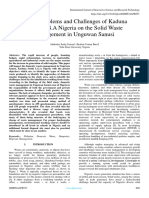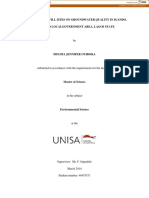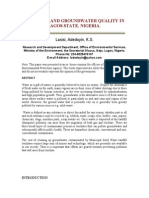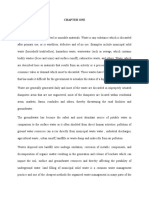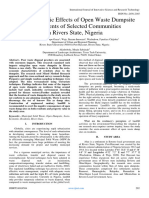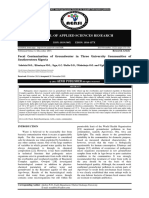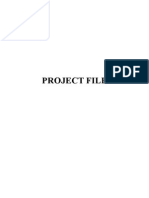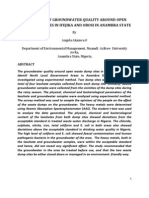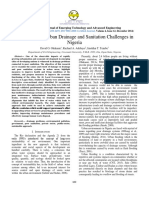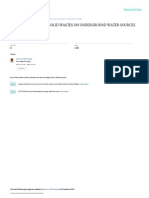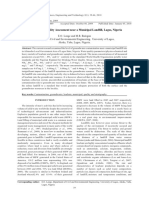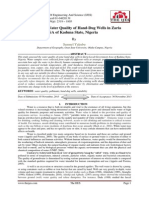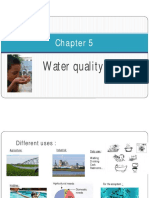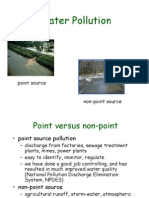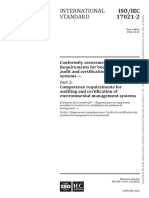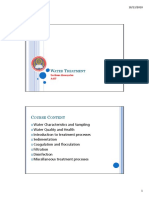Assessment of Underground Water Quality of Gosa Landfill Site of The Federal Capital Territory, Abuja Nigeria
Assessment of Underground Water Quality of Gosa Landfill Site of The Federal Capital Territory, Abuja Nigeria
Volume 10, Issue 4, April – 2025 International Journal of Innovative Science and Research Technology
ISSN No:-2456-2165 https://doi.org/10.38124/ijisrt/25apr2205
Assessment of Underground Water Quality of Gosa
Landfill Site of the Federal Capital Territory,
Abuja Nigeria
Oludele J. Ayoola 1; Emmanuel Afeonkhai 2; Raifu Olatunji Anibaba3
Department of Geography and Environmental Management, University of Abuja, Nigeria
Centre for Environmental Studies, University of Abuja, Abuja
Publication Date: 2025/05/19
Abstract: Increasing urbanization results in an increased generation of waste materials and landfills become the most
convenient way of disposal. Most of these landfills are mere “holes in the ground” and do not qualify as sanitary means of solid
waste disposal. Wastes placed in landfills or open dumps are subjected to either groundwater underflow or filtration from
precipitation, resulting to underground water pollution. The study assessed underground water quality of gosa landfill site of
the federal capital territory, Abuja Nigeria. It made use of primary data. primary data consist of water samples from the
selected wells in the study area. Simple random sampling was used to select wells and boreholes in the study area. Three
boreholes and three wells were selected from three communities (Hulumi, Jiyita and Paipe community) surrounding the
landfill while one borehole and one well was selected within the landfill making a total of eight (8) water samples. Samples
were stored in clean, sterilized, plastic bottles that were rinsed thoroughly with the samples at the collection point before
actual collection. The values of total chlorine (2.19mg/l and 5.04 mg/l), phosphate (6.3 mg/l and 9 mg/l), nitrate (21.8 mg/l and
47.4 mg/l), nitrite (1.08 mg/l for well), total iron (2.7 mg/l and 1.68 mg/l) and lead (1.99 mg/l and 1.08 mg/l) for borehole and
well respectively of the dumpsite are above safety standard set by Federal Ministry of Environment (fme). The value of
dissolved oxygen in borehole of Hulumi (7.82mg/l) well of dumpsite (7.51mg/l), borehole of Jiyita (7.82) and borehole of Paipe
(7.57mg/l) are above the safety standard set by fme of 7.5mg/l. The value of chlorine, Biological and chemical oxygen demand
and recorded at all sampling points is higher than safety limit set by fme of 0.2mg/l. More also, the value of copper recorded at
the borehole and well of Hulumi (1.08mg/l and 1.55mg/l) and Dumpsite (2.83mg/l and 1.3mg/l) are higher than value for safety
standard set by fme. Water of all sample sites contains significant amount of total coliform count and Fecal Coliform Count
with dumpsite recording highest value of total coliform count of 1600ml and 160ml for well and borehole and fecal coliform
count of 6.9 X 102ml and 4.90 X 102ml) for well and borehole respectively. In order to reduce the rate of pollution of
underground water quality in the study area construction of boreholes and wells close to septic tanks, latrines and gutters
should be prohibited by the respective Government regulatory agencies, the ministry should engage in serious enlightenment
campaign to educate the populace on water pollutants, effects and precautions, should in case the residents of the landfill insist
in drinking water from wells within the land fill, there should be daily purification of well and borehole water in the study
area through biological or chemical processes and there should be a periodic monitoring and assessment of water quality in
Gosa landfill to ascertain status at every given time.
Keywords: Ground Water, Landfill, Water Quality.
How to Cite: Oludele J. Ayoola; Emmanuel Afeonkhai; Raifu Olatunji Anibaba (2025) Assessment of Underground Water Quality of
Gosa Landfill Site of the Federal Capital Territory, Abuja Nigeria. International Journal of Innovative Science and Research
Technology, 10(4), 4168-4178. https://doi.org/10.38124/ijisrt/25apr2205
IJISRT25APR2205 www.ijisrt.com 4168
Volume 10, Issue 4, April – 2025 International Journal of Innovative Science and Research Technology
ISSN No:-2456-2165 https://doi.org/10.38124/ijisrt/25apr2205
I. INTRODUCTION precipitation. The dumped solid wastes gradually release its
initial interstitial water and some of its decomposition by-
Water is the natural and ecological resource that supports products get into the water moving through the waste deposit.
the existence of flora and fauna (plants and animals) on the Such liquid containing innumerable organic and inorganic
planet and a fundamental necessity for human life. An average compounds is called “Leachate’’. This leachate accumulates at
man (of 53- 63kg body weight), requires about 3 liters of the bottom of the landfill and percolates through the soil (Mor
water in liquid and food daily to keep healthy; Onweluzo and et al., 2006). Groundwater pollution is mainly due to the
Akuagbazie (2010). Water makes up more than two thirds of process of industrialization and urbanization that has
human body weight and without water, we would die in a few progressively developed over time without any regard for
days. Most people don’t think about water very much, but environmental consequences (Longe and Balogun, 2010).
water is much more essential to life. As a rule, you can survive Wastes of different types, mostly solid wastes are the major
weeks without food, but only a matter of days without water, input of dumpsites/ landfills, with respect to the hydrological
Cackowski (2015). Groundwater is the water located beneath analysis of groundwater, its flows from area of higher
the ground surface in soil pore spaces and in the fractures of topography towards area of lower topography, thereby
rock formation (United States Geological Survey (USGS, bringing about the examination of the degradable materials
2014). Groundwater is the largest available source of fresh which form leachate and contaminate the underground water.
water as two thirds of global fresh water is found underground
(Annenberg Leaner, 2012). About two billion people The ideal of safe drinking water places a lot of concern
worldwide use groundwater and up to 80% of drinking water on the quality water in question. In previous years, efforts
in Europe and Russia is groundwater (Earth Sciences for were made by Nigerian Government to improve the quality
Society Foundation, 2009). Once groundwater is contaminated status of domestic water supply in a bid to cope with demand
it may forever remain polluted without remedy or treatment. for portable water that is ever increasing in the light of the
Water is one of the determinants of human earth system. growing population and rural-urban drift. Federal Capital of
Diseases may spring up through water pollution, especially Nigeria is experiencing influx of population for administration
groundwater contaminants, and rapidly spread beyond human and economic reasons with its present population of about
expectation because of its flow mechanism (Afolayan et al., 2,153,000 (Nigerian Demographic Profile,2014). These have
2012). placed more pressure on the need to have safe drinking water
to meet up with the challenges of increasing population
Landfill practice is the disposal of solid waste by growth. Most part of the town is presently not connected with
infilling depression on land. The depression into which solid tap water. These people still depend on groundwater (hand
wastes are often dumped include valleys (abandoned) sites of dug wells and boreholes) for most of their water needs for
quarries, excavations, or sometimes a selected portion within domestic purposes, except where rain water is harvested
the residential and commercial areas in many urban during rainy season.
settlements where the capacity to collect, process dispose of,
or re-use solid waste in a cost-efficient, safe manner is often Gosa dumpsite is about 90.25 hectares of land allocated
limited. The practice of land filling system as a method of for open dumping within Idu Industrial Layout, Abuja
waste disposal in many developing countries is usually far Municipal Area Council (AMAC) in the Federal Capital
from standard recommendations (Mull, 2005; Adewole,2009; Territory. For the teeming population of Federal Capital City
Eludoyin & Oyeku,2010). A standard landfill system involves (FCC) surrounding Gosa Community, groundwater is the
carefully selected location, and is usually constructed and major source of water supply due to none provision and
maintained by means of engineering techniques, ensuring availability of pipe born water by the Federal Capital Territory
minimized pollution of air, water and soil and risks to man and Administration (FCTA). The dependence on groundwater for
animals. It involves placing wastes in lined pit or a mound domestic use could expose the people to wide range of water
(sanitary landfills) with appropriate means of leachate and related diseases like cholera, typhoid, dysentery, and diarrhea,
landfill gas control (Alloway & Ayres 1997; Eludoyin & as it has been established that water related diseases results
Oyeku 2010). Land filling of municipal solid wastes is a from the contamination of water bodies. Where anthropogenic
common waste management practice and one of the cheapest processes (i.e landfills) can bring about the pollution of water
methods for organized waste management in many parts of the body, it is therefore important to study water quality in these
world (El-Fadel et al; 1997; Longe & Balogun, 2010). areas especially those around landfill sites to determine its
impacts on groundwater quality. Hence, this research assessed
Increasing urbanization results in an increased generation how wastes affect underground water quality in Gosa
of waste materials and landfills become the most convenient dumpsite and its implication on the health of resident who
way of disposal. Most of these landfills are mere “holes in the consumes this water in the study area
ground” do not qualify as sanitary means of solid waste
disposal. Wastes placed in landfills or open dumps are
subjected to either groundwater underflow or filtration from
IJISRT25APR2205 www.ijisrt.com 4169
Volume 10, Issue 4, April – 2025 International Journal of Innovative Science and Research Technology
ISSN No:-2456-2165 https://doi.org/10.38124/ijisrt/25apr2205
II. MATERIALS AND METHODS
Soil of the study area is influenced with alluvial soil of
Study Area Iku plains, gleysols and fluvisols. soils are complex in their
The present main landfill site for FCC being supervised degree of taxonomic variations. Drainage conditions of the
by AEPB is located at Gousa landfill site located in Gousa soil depend on the depth of water table. The colour of the soils
district of AMAC near the Nnamdi Azikwe International is modified by mottling due to poor drainage. The area has
Airport, lies on latitude 9° 01’ 08.49’’N to 9° 03’ 41.04’’ N clayish and sandy loam soil texture with occasional swampy
and longitude 70 21’ 05’’ E to 7° 22’ 59’’E. areas used for wetland (irrigated) farming. These are the
upland soils of the ferruginous red tropical type, often derived
The climate is the hot and humid tropical type. It is such from crystalline acid or sandy rocks and contained high
that its elements have ranges that are transitional from those of proportion of silt. They are most suited for cereal and tuber
the southern and northern parts of the country. The area has production (Balogun, 2001).
distinct wet (March - October) and dry (November - February)
seasons with average annual rainfall of 1358.7mm and mean The study area has a vast land conducive for agricultural
temperature range of between 20.70C - 30.80C (Balogun, activities. The rich and fertile land makes it suitable for
2001). Rainfall play a vital role with respect to agricultural cultivation of varieties of crops with large spread of fadama
activities within the study area and most farming activities land estimated to be over 40,000 hectares and suitable for rice
highly depend on rainfall (Balogun, 2001). farming (CIFIIIP, 2013).
Fig 1: Federal Capital Territory showing of the Study Area
Source: UniAbuja Gis Lab
IJISRT25APR2205 www.ijisrt.com 4170
Volume 10, Issue 4, April – 2025 International Journal of Innovative Science and Research Technology
ISSN No:-2456-2165 https://doi.org/10.38124/ijisrt/25apr2205
The Climate favours the production of a wide variety of selected from three communities (Hulumi, Jiyita and Paipe)
crops, which include legumes (groundnuts, soyabean, lima surrounding the landfill while one borehole and one well were
bean, bambara nut and pigeon pea), cereals (maize, millet, selected within the landfill, making a total of eight (8) water
sorghum and rice), solanaceous crops (peppers, tomato, samples in the study area.
garden eggs and ginger), tree crops (guava, cashew, mango,
orange and paw-paw), and root and tuber crops (yam, sweet The water samples were collected in a plastic bottle of
potatoes, cocoyam and cassava). For livestock production, the approximately 1.5 litre capacity. The bottles were rinsed three
animals that are mostly kept are swine, goats, sheep and times with the sample water. The containers were filled to
poultry. Hunting and bee-keeping are also practiced (CIFIIIP, capacity and caps screwed tightly to eliminate bubbles.
2013). The area is mainly occupied by small holding rain fed Masking tape was used to close any gap between the bottle
and irrigation farmers who grow yam, rice, melon seed, and the cap. The bottles were fully labeled with location, date,
cocoyam, cassava, pepper, tomato, okra rice, onion, garden operating condition of the source and the number of the
eggs, spinach, beniseed and millet among others (CIFIIIP, sample. Then the sample was taken to Abuja Environmental
2013). Protection Board (AEPB) Laboratory for chemical, physical,
heavy metals and bacteriological analyses. Analyses were
Sampling Procedure conducted on the samples by AEPB officials in attendance and
Random sampling was used to select wells and boreholes results will be obtained for interpretation.
in the study area. Three boreholes and three wells were
Plate 1: Water Sample Collection in the Dumpsite
III. RESULTS AND DISCUSSION temperature of water samples fall within the Federal Ministry
of Environment Standard of 400c.
Physical and Chemical Characteristics of Water in the
Study Area The result of the value of pH of water sample taking in
Table 1 shows that well in jiyita and paipe recorded the well in dumpsite and paipe recorded the minimum pH value of
minimum value of temperature of 32.20c while the dumpsite 6.4 while Jiyita community have the highest recorded pH
has the highest recorded value of temperature of 32.90c. value of 7.2. Boreholes in jiyita and paipe community have the
Boreholes in the dumpsite and Hulimi community have the minimum pH value of 6.4, while hulumi community and
minimum value of temperature of 32.30c while Paipe dumpsite recorded the highest value of 6.8. The temperature
community recorded the highest value of 32.80c. The value of value of water samples falls within the Federal Ministry of
Environment Standard of 6-9.
IJISRT25APR2205 www.ijisrt.com 4171
Volume 10, Issue 4, April – 2025 International Journal of Innovative Science and Research Technology
ISSN No:-2456-2165 https://doi.org/10.38124/ijisrt/25apr2205
The well in jiyita community recorded the minimum highest recorded value of 68.48mg/l. Boreholes in jiyita
value of dissolve oxygen of 4.08mg/l while the dumpsite has community have the minimum value of 34.42mg/l while
the highest recorded value of dissolve oxygen of 7.51mg/l. dumpsite recorded the highest value of 102.72mg/l. The value
Boreholes in the dumpsite have the minimum value of of calcium hardness of all water samples fall within the
dissolved oxygen of 3.09mg/l while hulumi and jiyita Federal Ministry of Environment Standard of 150mg/l.
community recorded the highest value of 7.82mg/l. The value
of dissolve oxygen of all water samples fall within the Federal well in paipe community recorded the minimum value of
Ministry of Environment Standard of 7.5mg/l except the value 0.11mg/l of total chlorine while the dumpsite has the highest
recorded in the borehole of hulumi and jiyita community. recorded value of 5.04mg/l. Boreholes in jiyita community
have the minimum value of 0.218mg/l while dumpsite
The well in hulumi community recorded the minimum recorded the highest value of 2.19mg/l. The value of total
value of conductivity of 119µS/cm while the jiyita community chlorine of all water samples are above the Federal Ministry of
has the highest recorded value of conductivity of 368µS/cm. Environment Standard of 0.2mg/l.
Boreholes in the jiyita have the minimum conductivty of
173µS/cm while dumpsite recorded the highest value of well in hulumi community recorded the minimum value
742µS/cm. The value of conductivity of all water samples fall of sulphate of 6.8mg/l while the dumpsite has the highest
within the Federal Ministry of Environment Standard of recorded value of 36.9mg/l. Boreholes in paipe community
1000µS/cm. have the minimum value of 1mg/l while dumpsite recorded the
highest value of 27.1mg/l. The value of sulphate of all water
The value on table 1 further revealed that well in hulumi samples fall within the Federal Ministry of Environment
community recorded the minimum value of total dissolve solid Standard of 500mg/l.
of 59.5mg/l while the jiyita community has the highest
recorded value of total dissolve solid of 184mg/l. Boreholes in well in hulumi community recorded the minimum value
the jiyita have the minimum value of 87mg/l while dumpsite of chloride of 22mg/l while the dumpsite has the highest
recorded the highest value of 372mg/l. The value of total recorded value of 130mg/l. Boreholes in hulumi community
dissolve solid of all water samples fall within the Federal have the minimum value of 17mg/l while dumpsite recorded
Ministry of Environment Standard of 2000mg/l. the highest value of 97mg/l. The value of chloride of all water
samples fall within the Federal Ministry of Environment
The result revealed that well in hulumi community Standard of 600mg/l.
recorded the minimum value of total hardness of 68.34mg/l
while the dumpsite has the highest recorded value of total well in hulumi community recorded the minimum value
hardness of 102.72mg/l. Boreholes in jiyita community have of phosphate of 0.9mg/l while the dumpsite has the highest
the minimum value of 51.36mg/l while dumpsite recorded the recorded value of 9. Boreholes in hulumi community have the
highest value of 136.96mg/l. The value of total hardness of all minimum value of 0.95mg/l while dumpsite recorded the
water samples fall within the Federal Ministry of Environment highest value of 6.3mg/l. The value of phosphate of all water
Standard of 200mg/l. samples fall within the Federal Ministry of Environment
Standard of 5.5mg/l except for the samples on dumpsite which
well in dumpsite recorded the minimum value of 10mg/l are above the FME standard.
of total alkalinity while the hulumi and jiyita community has
the highest recorded value of 15mg/l. Boreholes in the three well in jiyita community recorded the minimum value of
communities have the minimum value of 10mg/l while nitrate 9mg/l while the dumpsite has the highest recorded
dumpsite recorded the highest value of 18mg/l. The value of value of 47.4mg/l. Boreholes in paipe community have the
total alkalinity of all water samples fall within the Federal minimum value of 12mg/l while dumpsite recorded the
Ministry of Environment Standard of 100mg/l. highest value of 21.8mg/l. The value of nitrate of all water
samples fall within the Federal Ministry of Environment
well in three communities recorded the minimum value Standard of 20mg/l except for the samples on dumpsite which
of 17.12mg/l of magnesium hardness while the dumpsite has are above the FME standard.
the highest recorded value of 34.24mg/l. Boreholes in jiyita
and paipe community have the minimum value of 17.12mg/l well in paipe community recorded the minimum value of
while dumpsite and Hulumi community recorded the highest nitrite of 0.055mg/l while the dumpsite has the highest
value of 34.24mg/l. The value of Magnesium hardness of all recorded value of 1.08mg/l. Borehole in hulumi community
water samples fall within the Federal Ministry of Environment has the minimum value of 0.007mg/l while dumpsite recorded
Standard of 50mg/l. the highest value of 0.99mg/l. The value of nitrite of all water
samples fall within the Federal Ministry of Environment
well in hulumi community recorded the minimum value Standard of 1mg/l except for the samples on the well of the
of 34.24mg/l of calcium hardness while the dumpsite has the dumpsite which is above the FME standard.
IJISRT25APR2205 www.ijisrt.com 4172
Volume 10, Issue 4, April – 2025 International Journal of Innovative Science and Research Technology
ISSN No:-2456-2165 https://doi.org/10.38124/ijisrt/25apr2205
community recorded the highest value of 47mg/l. The value of
well in paipe community recorded the minimum value of biochemical oxygen demand of all water samples are above
ammonia of 0.04mg/l while the dumpsite has the highest the Federal Ministry of Environment Standard of 30mg/l
recorded value of 6. Boreholes in jiyita community have the except for the samples on hulumi community and well on
minimum value of 0.04mg/l while dumpsite recorded the paipe community which their values are below the set
highest value of 6mg/l. The value of ammonia of all water standard.
samples fall within the Federal Ministry of Environment well in jiyita community recorded the minimum value of
Standard of 10mg/l. COD of 120mg/l while the dumpsite has the highest recorded
value of 640mg/l. Boreholes in jiyita and paipe community
well in hulumi community recorded the minimum value have the minimum value of 140mg/l while dumpsite recorded
of BOD of 19mg/l while the dumpsite and paipe community the highest value of 640mg/l. The value of chemical oxygen
has the highest recorded value of 47mg/l. Boreholes in hulumi demand of all water samples are above the Federal Ministry of
community have the minimum value of 23mg/l while jiyita Environment Standard of 80mg/l.
Table 1: Physical and Chemical Characteristics of Water in the Study Area
S/ PARAMETE HULUMI HULUMI DUMPSIT DUMPSIT JINITA JINITA PAIPE PAIPE
N RS VILLAGE VILLAGE E GOSA E GOSA VILLAGE VILLAGE VILLAGE VILLAGE
WELL BOREHO WELL BOREHO BOREHO WELL WELL BOREHO
LE LE LE LE
A
PHYSICAL TEST
1. Odour Unobjectio Unobjectio Unobjectio Unobjectio Unobjectio Unobjectio Unobjectio Unobjectio
nable nable nable nable nable nable nable nable
2 Temperature(o 32.8 32.3 32.9 32.3 32.7 33.2 33.2 32.8
C)
3 pH 6.8 6.8 6.4 6.8 6.4 7.2 6.4 6.4
4 Dissolve 5.71 7.82 7.51 3.09 7.82 4.08 7.44 7.57
Oxygen(mg/l)
5 Conductivity(µ 119 221 288 743 173 368 215 269
S/cm)
6 Total dissolved 59.5 110.8 144 372 87 184 107.5 135
solids(mg/l)
B
CHEMICAL TEST
7 Total 68.34 102.72 102.72 136.96 51.36 68.42 68.48 85.6
Hardness(mg/l)
8 Total 15 10 10 18 10 15 14 10
alkalinity(mg/l)
9 Magnesium 17.12 34.24 34.24 34.24 17.12 17.12 17.12 17.12
Hardness
(mg/l)
10 Calcium 34.24 68.48 68.48 102.72 34.24 51.36 51.36 68.48
Hardness
(mg/l)
11 Total 0.703 0.218 5.04 2.19 0.653 0.831 0.11 0.596
Chlorine(mg/l)
12 Sulphate (mg/l) 6.8 7.5 36.9 27.1 15.1 8.2 100 1.0
Chloride (mg/l) 22 17 130 97 33 68 34 68
13 Phosphate 0.9 0.95 9.0 6.3 2.9 3 3.05 3.0
(mg/l)
14 Nitrate as 15 13 47.4 21.8 12.0 9.0 10.0 9.0
Nitrogen(mg/l)
15 Nitrite as 0.605 0.007 1.08 0.99 0.056 0.204 0.055 0.204
Nitrogen (mg/l)
16 Ammonia as 0.5 0.4 6.0 6.0 0.04 0.05 0.04 0.05
Nitrogen
IJISRT25APR2205 www.ijisrt.com 4173
Volume 10, Issue 4, April – 2025 International Journal of Innovative Science and Research Technology
ISSN No:-2456-2165 https://doi.org/10.38124/ijisrt/25apr2205
17 Biochemical 23 19 39 47 34 47 28 47
Oxygen
Demand(mg/l)
18 Chemical 160 200 640 640 120 140 140 140
Oxygen
Demand(mg/l)
Source: Fieldwork, 2019.
Heavy Metal Properties of Water Samples in The Study samples in the three communities fall within the Federal
Area Ministry of Environment Standard of 1.5mg/l while the value
The result in table 2 revealed that well in hulumi gotten from dumpsite is higher than the set standard.
community recorded the minimum value of chromium of
0.006mg/l while the jiyita community has the highest recorded well in hulumi community recorded the minimum value
value of 0.82mg/l. Boreholes in hulumi community have the of manganese of 0.02mg/l while the dumpsite has the highest
minimum value of 0.006mg/l while paipe community recorded recorded value of mamganese of 0.16mg/l. Boreholes in jiyita
the highest value of 0.82mg/l. The value of chromium of all community have the minimum value of manganese of 0.006
water samples fall within the Federal Ministry of Environment while dumpsite recorded the highest value of 0.18mg/l. The
Standard of <1mg/l. values of manganese of all the water samples fall within the
Federal Ministry of Environment Standard of 0.2mg/l.
The result shows that well in hulumi and jiyita
community recorded the minimum value of cadmium of well in paipe community recorded the minimum value of
0.003mg/l while the paipe community has the highest recorded zinc of 0.06mg/l while the dumpsite has the highest recorded
value of 0.006mg/l. Boreholes in dumpsite have the minimum value of zinc of 2.15mg/l. Boreholes in hulumi community
value of 0.001mg/l while jiyita community recorded the have the minimum value of zinc of 0.24mg/l while dumpsite
highest value of 0.015mg/l. The value of cadmium of all water recorded the highest value of 1.19mg/l. The values of zinc of
samples fall within the Federal Ministry of Environment all the water samples fall within the Federal Ministry of
Standard of <1mg/l. Environment Standard of 3mg/l.
The result in table 2 revealed that well in jiyita well in jiyita community recorded the minimum value of
community recorded the minimum value of copper of silicon of 0.5mg/l while the dumpsite has the highest recorded
0.25mg/l while the dumpsite has the highest recorded value of value of silicon of 35mg/l. Boreholes in paipe community
2.83mg/l. Boreholes in paipe community have the minimum have the minimum value of silicon of 0.5mg/l while dumpsite
value of 0.25mg/l while hulumi community recorded the recorded the highest value of 20mg/l. The FME standard was
highest value of 1.55mg/l. The value of copper of water not detected for silicon.
samples in paipe and jiyita fall within the Federal Ministry of
Environment Standard of <1mg/l while the value gotten from Table 2 further show that well in jiyita community
dumpsite and hulumi community is higher than the set recorded the minimum value of lead of 0.007mg/l while the
standard. dumpsite has the highest recorded value of lead of 1.99mg/l.
Boreholes in paipe and jiyita community have the minimum
The result also show that well in paipe community value of lead of 0.007mg/l while dumpsite recorded the
recorded the minimum value of total iron of 0.09mg/l while highest value of 1.08mg/l. The values of lead of the water
the dumpsite has the highest recorded value of total iron of samples of the three communities fall within the Federal
2.7mg/l. Boreholes in hulumi community have the minimum Ministry of Environment Standard of 0.1mg/l while values
value of total iron of 0.8mg/l while dumpsite recorded the recorded on the dumpsite is higher than the set standard by
highest value of 1.68mg/l. The value of total iron of water FME.
IJISRT25APR2205 www.ijisrt.com 4174
Volume 10, Issue 4, April – 2025 International Journal of Innovative Science and Research Technology
ISSN No:-2456-2165 https://doi.org/10.38124/ijisrt/25apr2205
Table 2: Heavy Metal Properties of Water Samples in the Study Area
S/ PARAMETE HULUM HULUMI DUMPSIT DUMPSIT JINITA JINITA PAIPE PAIPE
N RS I VILLAGE E GOSA E GOSA VILLAGE VILLAG VILLAG VILLAGE
VILLAG BOREHO WELL BOREHO BOREHO E E BOREHO
E LE LE LE WELL WELL LE
WELL
HEAVY METALS
1 Chromium(mg 0.010 0.006 0.59 0.45 0.20 0.82 0.008 0.82
/l)
2 Cadmium(mg/l 0.003 0.003 0.005 0.001 0.015 0.003 0.006 0.003
)
3 Copper(mg/l) 1.08 1.55 2.83 1.30 0.63 0.25 0.53 0.25
4 Iron 0.4 0.8 2.70 1.68 1.0 1.25 0.09 1.25
Total(mg/l)
5 Manganese 0.02 0.025 0.16 0.18 0.006 0.02 0.03 0.02
(mg/l)
6 Zinc (mg/l) 0.13 0.24 2.15 1.19 0.39 1.06 0.06 1.06
7 Silicon (mg/l) 10.2 10.0 35.0 20.0 ND 0.5 0.6 0.5
8 Lead(mg/l) 0.008 0.008 1.99 1.08 0.007 0.007 0.018 0.007
Bacteriological Content of the Sample Water
The result in table 3 show that well in hulumi community recorded the minimum value of totalcoliform count of 920MPN/mL
while the dumpsite, jiyita and paipe has the highest recorded value of 1600MPN/mL, boreholes in hulumi community have the
minimum value of 540MPN/mL while dumpsite recorded the highest value of 1600MPN/mL. For fecal coliform count, well in hulumi
community recorded the minimum value of 156CFU/mL while the dumpsite has the highest recorded value of 690CFU/mL, boreholes
in hulumi community have the minimum value of 120CFU/mL while dumpsite recorded the highest value of 490CFU/mL. The values
of total coliform count of all water samples of the study are above the Federal Ministry of Environment Standard of 1.8 MPN/mL
while for fecal coliform count, samples on dumpsite, paipe and jiyita are above the FME standard of 200 CFU/mL while the values on
hulumi communities are below the FME standard of 200 CFU/mL.
Table 3: Bacteriological Content of the Sample Water
S/ PARAMETERS HULUM HULUMI DUMPSI DUMPSIT JINITA JINITA PAIPE PAIPE
N I VILLAGE TE GOSA E GOSA VILLAGE VILLA VILLA VILLAGE
VILLA BOREHO WELL BOREHO BOREHO GE GE BOREHO
GE LE LE LE WELL WELL LE
WELL
1 Total Coliform 920 540 1600 1600 920 1600 1600 540
Count(MPN/mL)
2 Fecal Coliform 1.56 X 1.20 X 102 6.9 X 102 4.90 X 102 3.0 X 102 4.8 X 102 3.1 X 102 4.8 X 102
Count (CFU/mL) 102
3 E-coli + + + + + + + +
4 Salmonella) + + + + + + + +
5 Shigella(CFU/100 + + + + + + + +
ml)
6 Enterobacter + + + + + + + +
Source: Field Work, 2019
IJISRT25APR2205 www.ijisrt.com 4175
Volume 10, Issue 4, April – 2025 International Journal of Innovative Science and Research Technology
ISSN No:-2456-2165 https://doi.org/10.38124/ijisrt/25apr2205
IV. DISCUSSION OF RESULT the FME safety limit, value of Biochemical Oxygen Demand
(BOD) on dumpsite and Jiyita community is above the safety
The finding shows that the value of temperature, pH, limit, values of Chemical Oxygen Demand (COD) and total
conductivity, total dissolve solid, total hardness, total colifom count of all sampling point are above the safety limit
alkalinity, magnesium hardness, calcium hardness, sulphate, set by FME, values of fecal coliform count on dumpsite, paipe
chloride, cadmium, ammonia, chromium manganese and zinc and jiyita are above the FME standard, value of copper in
of all study site sample water are within the safety limit set by Hulumi community and dumpsite are above the safety limit
federal ministry of environment, also values of total chlorine, and values of silicon on Hulumi community and the dumpsite
phosphate, nitrate, nitrite, total iron and lead of the three are above the safety limit set by FME.
communities ( paipe, hulumi and paipe) are below the set
standard of FME safety limit except the values on the This shows that the activity on the dumpsite also has
dumpsite which is higher than the set safety limit by FME. In effect on the neighboring surrounding as water percolate under
other words, values of total chlorine, phosphate, nitrate, nitrite, the ground, this water flow into wells and underground water
total iron and lead recorded on the dumpsite is higher than the close to the dumpsite. people living in this three settlement are
set safety limit by FME. This implies that water used on the prone to the negative effect of BOD, COD, copper and silicon.
landfill is polluted. The result show elevates level of nitrate, Copper, this is a natural occurring metal found in rock, soil,
this could be as a result of shallow, poorly constructed well in water and sediment, get into water through household
the study area. high value of lead and chromium can be plumbing, faucets and water mixtures (WHO, 2006). Only a
attributed to metal and electronics dumped at the landfill. small amount of copper is essential for good health. Exposure
to high doses can cause health problems, short term exposure
High value of lead on the dumpsite can cause a variety of can cause gastrointestinal distress while long term exposure
adverse health effects when people are exposed to it for can cause anemia and disrupt liver and kidney functions.
relatively short periods. These effects may include Furthermore the high value of total coliform count and fecal
interference with red blood-cell chemistry, delays in normal count can be traced to the disintegration of solid waste to
physical and mental development in babies and young liquid waste which has percolate down into the underground
children, deficits in attention span, hearing and learning layer, Total Coliform are bacteria that are found in the soil, in
abilities of children and increases in the blood pressure of water and human or animal waste; they make human sick if
adults. Long-term exposure to lead has the potential to cause ingested while Faecal Coliform in water may not be directly
stroke, kidney disease and cancer (USEPA, 2012). Chromium harmful and does not indicate the presence of faeces but can
occurs naturally in the environment from the erosion of natural be harmful to the environment as its can reduce dissolved
chromium deposit (EPA, 2008). Effect of high chromium oxygen levels if discharged into rivers or waterways. Some
includes skin irritation or ulceration, allergic contact, water borne pathogens diseases that may coincide with faecal
dermatitis, occupational asthma, nasal irritation and ulceration, coliform contamination include ear infections, dysentery,
people living on the dumpsite are highly at risk of this effect, typhoid fever viral and bacterial gastro enteritis and hepatitis
as the result of chromium obtain on the dumpsite is very high. A. this is are all serious health challenge that the resident of
These effects may include interference with red blood-cell the study area is in danger of.
chemistry, delays in normal physical and mental development
in babies and young children, deficits in attention span, V. CONCLUSION AND RECOMMENDATION
hearing and learning abilities of children and increases in the
blood pressure of adults. Access to safe water is essential to health, a basic human
right and a component of effective policy for health
High level of Nitrate in drinking water on the dumpsite protection. The importance of water, sanitation and hygiene
can also be an indicator of overall water quality. Elevated for health development has been reflected in the outcomes of a
nitrate levels may suggest the possible presence of other series of international policy forums which include health-
contaminants such as disease-causing organisms, pesticides, or oriented conferences such as the 1977 World Water
other inorganic and organic compounds that could cause Conference in Mar Del Plata, Argentina, that launched the
health problems. Nitrates are essential source of nitrogen for water supply and sanitation decade of 1981-1990, the
plants. Human and animal wastes can contribute to nitrate International Conference on Primary Health Care, Kazakhstan
contamination of ground water. Agricultural practices have (former Soviet Union) in 1978; as well as the Millennium
been linked to elevated levels of nitrate in drinking water, Development Goals adopted by the General Assembly of the
although any well can become contaminated by nitrates, United Nations (UN) in 2000.
shallow, poorly constructed, or improperly located wells are
more susceptible to contamination. Abuja Municipal area council, like any other growing
area council in Nigeria, has witnessed dramatic increase in
More also the value of dissolve oxygen of the borehole human population over the past decades, which exerted
of the three communities within the dumpsite are higher than pressure on the nature of waste generated and cause increase
IJISRT25APR2205 www.ijisrt.com 4176
Volume 10, Issue 4, April – 2025 International Journal of Innovative Science and Research Technology
ISSN No:-2456-2165 https://doi.org/10.38124/ijisrt/25apr2205
in number of waste dump at Gosa landfill this has cause REFERENCES
naturally fragility on the surface and ground water sources use
for domestic purposes within the dumpsite. It is thus, [1]. Afolayan, O.S, Ogundele, F.O, Omotayo, A. (2012).
unexpected that the quality of potable water in the area will Comparative analysis of the Effect of closed and
remain unchanged. The study shows that the activity of the operational landfills in groundwater quality in Solous,
landfill in terms of waste dump has cause increase in the bio- Lagos, Nigeria. Journal of Applied Technology in
chemical and heavy metal contain of the water where most Environmental Sanitation, 2(1), 67-76.
value of the observe biochemical and heavy metal properties [2]. Adewole, A.T (2009). Waste Management towards
of the collected water samples are higher than the safety limit sustainable development in Nigeria: A case study of
set by federal ministry of environment. The va,ue of Total
Lagos State. International NGO Journal, 4(4), 173-179.
chlorine, phosphate, nitrate, nitrite, biochemical oxygen
demand, chemical oxygen demand, coper, total iron silicon, [3]. Alloway, B.J. & Ayres, D.C. (1997). Chemical Principles
lead, total colifom count and fecal count observed on the of Environmental Pollution, In: Wastes and their
landfill is higher than safety limit set by FME. Increase in this Disposal (2nd ed). London: Blackie Academic
entire chemical above can pose a serious threat to the health of Professional.
the resident of the study area most especially lead. [4]. Balogun, O. (2001). The Federal Capital Territory of
Nigeria: Geography of Its Development. University of
While the study mad efforts to further add to the growing Ibadan Press Limited. Basil Blackwell, New York.
body of knowledge on water quality studies, it is suggested [5]. Carter JD, Barber W, Tait EA, Jones GP (1963) The
that similar studies be carried out periodically in all other geology of parts of Adamawa, Bauchi and Borno
landfills within FCT, as a starting point towards achieving the Provinces in Northeastern Nigeria. Geol Surv Niger Bull
MDG number 7 which is concerned with ensuring that safe 30:108 pp
water is accessible to at least over 100 million slums dwellers
[6]. Cackowski, Colleen (2015). ‘The Importance of Good
by 2015. It is also suggested that the key area of water quality
Quality Water- What You Need to Know- Longevity
(such as anthropogenic and natural factors responsible for
concentration of contaminants in water, measures for treating Warehouse Blog. Longevity Warehouse Blog. N.P.,
polluted water sources, etc) should also be investigated in this 2015, Web. 15 Oct. 2015.
study area. [7]. Compendium on Implementation of theFadama III
project inFederal Capital Territory (CIFIIIP), (2013);
Based on the findings, the study further recommends the [8]. Earth sciences for social foundation. (2009).
following: Groundwater reservoir for a thirsty planet? Retrieved
Construction of boreholes and wells close to septic tanks, from:
latrines and gutters should be prohibited by the respective http//www.fearofplanetearth.org/content/downloads/grou
Government regulatory agencies; in other words, the ndwater.pdf
scavengers living within the dumpsite should be provided [9]. El-Fadel, M., Findi Kakis, A.N. & Leckie, J.O. (1997).
with water from outside the landfill through daily Environmental Impacts of Solid Waste Landfilling.
distribution of water from tanks. Journal of Environmental Management, 50(1), 1-25Mull,
The Ministry should engage in serious enlightenment E.J. (2005). Approaches towards Sustainable Urban
campaign to educate the populace on water pollutants, Solid Waste Management: sahakarangar Layout. Thesis
effects and precautions; so has to discourage the (M.sc)- Lund University Lund.
scavengers from further drinking of water within the [10]. Eludoyin, A. O. & Oyeku, O. T. (2010). Heavy metal
landfill. contamination of groundwater resources in a Nigerian
Should in case the residents of the landfill insist in urban settlement. African Journal of Environmental
drinking water from wells within the land fill there should Science and Technology, 4(4), 201 – 214
be daily purification of this water through biological or [11]. EPA, 2008a. Background Information Document for
chemical processes. Updating AP42 Section 2.4 for Estimating Emissions
There should be a periodic monitoring and assessment of from Municipal Solid Waste Landfills. National Risk
water quality in Gosa landfill to ascertain status at every Management Research Laboratory, Air Pollution
given time; Prevention and Control Division, U.S. EPA. September
2008.
http://www.epa.gov/ttn/chief/ap42/ch02/draft/db02s04.p
df
IJISRT25APR2205 www.ijisrt.com 4177
Volume 10, Issue 4, April – 2025 International Journal of Innovative Science and Research Technology
ISSN No:-2456-2165 https://doi.org/10.38124/ijisrt/25apr2205
[12]. EPA, 2008b. Clean Energy Strategies for Local
Governments, Section 7.4: Landfill Methane Utilization,
Draft. Landfill Methane Outreach Program (LMOP),
Climate Change Division, U.S. EPA. December 10,
2008.
http://www.epa.gov/statelocalclimate/documents/pdf/7.4
_landfill_methane_utilization.pdf
[13]. Longe E.O. & Balogun, M.R. (2010). Groundwater
quality assessment near a municipal landfill, Lagos,
Nigeria. Research Journal of Applied Sciences,
Engineering and Technology 2(1), 39-44.
[14]. Mor, S., Ravindra, K., Dahiya, R.P. & Chandra, A.
(2006). Leachate Characterization and Assessment of
Groundwater Pollution near Municipal Solid Waste
Landfill Site. Environmental Monitoring and
Assessment, 118: 435-456.
[15]. Mull, E.J. (2005). Approaches towards Sustainable
Urban Solid Waste Management: sahakarangar Layout.
Thesis (M.sc)- Lund University Lund.
[16]. Onweluzo, J.C. and Akuagbazie, C.A. (2010).
Assessment of the quality of bottled and sachet water
sold in Nsukka Town. Agro-science Journal of Tropical
Agriculture, Food, Environment and Extension volume 9
number 2, pp. 104-110.
[17]. U.S. Environmental Protection Agency (2012).
Dissolved Oxygen and Biochemical Oxygen demand
[Retrieved October 14, 2014 from
http://water.epa.gov/type/rs1/monitoring/vms52.cfm]
[18]. U.S. Geological Survey (2014). Retrieved October 14,
2014 from
http://water.usgs.gov/edu/earthhowmuch.html]
[19]. World Health Organization (2006). Rapid Assessment of
Drinking Water Quality. Country Report Nigeria.
IJISRT25APR2205 www.ijisrt.com 4178
You might also like
- Status, Problems and Challenges of Kaduna South L.G.A Nigeria On The Solid Waste Management in Unguwan SanusiNo ratings yetStatus, Problems and Challenges of Kaduna South L.G.A Nigeria On The Solid Waste Management in Unguwan Sanusi7 pages
- Poject Proposal by Jonathan Rotji GurumjiNo ratings yetPoject Proposal by Jonathan Rotji Gurumji38 pages
- Groundwater Problems Caused by Irrigation With Sewage EffluentNo ratings yetGroundwater Problems Caused by Irrigation With Sewage Effluent54 pages
- Effects of Landfill Sites On Groundwater Quality in Igando, Alimosho Localgovernment Area, Lagos StateNo ratings yetEffects of Landfill Sites On Groundwater Quality in Igando, Alimosho Localgovernment Area, Lagos State117 pages
- GrossArchive - The Impact of Solid Waste Landfills in NigeriaNo ratings yetGrossArchive - The Impact of Solid Waste Landfills in Nigeria62 pages
- Responding and Identifying To Developmental Delay in ChildrenNo ratings yetResponding and Identifying To Developmental Delay in Children14 pages
- Assessment of Waste Generation and Sanitation Strategies For Sustainable Environmental Management in Akungba Akoko NigeriaNo ratings yetAssessment of Waste Generation and Sanitation Strategies For Sustainable Environmental Management in Akungba Akoko Nigeria9 pages
- Solid Waste Generation, Disposal and Management in Akure, Ondo State, NigeriaNo ratings yetSolid Waste Generation, Disposal and Management in Akure, Ondo State, Nigeria7 pages
- Sam-Uroupa and Ogbeibu 2020 - Solid Waste and Water Quality Benin RiverNo ratings yetSam-Uroupa and Ogbeibu 2020 - Solid Waste and Water Quality Benin River26 pages
- Pond Treatment Technology A Shilton Instant Download100% (1)Pond Treatment Technology A Shilton Instant Download88 pages
- 5 Groundwater Quality in Nigerian Urban AreasNo ratings yet5 Groundwater Quality in Nigerian Urban Areas13 pages
- Factors Influencing Consumer Buying Behavior of Toe Gold and Jewelry ShopNo ratings yetFactors Influencing Consumer Buying Behavior of Toe Gold and Jewelry Shop10 pages
- Electrical Resistivity Investigation For Aquifer Vulnerability To Surface Contaminants at Dumpsites in Western Niger DeltaNo ratings yetElectrical Resistivity Investigation For Aquifer Vulnerability To Surface Contaminants at Dumpsites in Western Niger Delta17 pages
- 2021 Quality of Drinking Water in Piwoyi AbujaNo ratings yet2021 Quality of Drinking Water in Piwoyi Abuja21 pages
- Assessment of Hydrochemistry Facies TypeNo ratings yetAssessment of Hydrochemistry Facies Type22 pages
- The Pollution Effects of Indiscriminate Disposal of Wastewater On Soil in Semi-UrbanNo ratings yetThe Pollution Effects of Indiscriminate Disposal of Wastewater On Soil in Semi-Urban8 pages
- An Efficiency Assessment of Lower Usuma Water Treatment Plant in Abuja Metropolis, NigeriaNo ratings yetAn Efficiency Assessment of Lower Usuma Water Treatment Plant in Abuja Metropolis, Nigeria8 pages
- Groundwater Quality Assessment Abandoned Dumpsite Osogbo 2021No ratings yetGroundwater Quality Assessment Abandoned Dumpsite Osogbo 20217 pages
- Evaluation of Quality and Irrigation Characteristics of Surface Water From Okochiri Creek in Rivers State NigeriaNo ratings yetEvaluation of Quality and Irrigation Characteristics of Surface Water From Okochiri Creek in Rivers State Nigeria14 pages
- Evaluation of Some Low-Cost Materials in Removing Pollutants From WastewaterNo ratings yetEvaluation of Some Low-Cost Materials in Removing Pollutants From Wastewater9 pages
- Exploring The Effects of Waste Disposal On Groundwater Quality in Port Harcourt, NigeriaNo ratings yetExploring The Effects of Waste Disposal On Groundwater Quality in Port Harcourt, Nigeria9 pages
- Leachate and Groundwater Quality in Lagos Final100% (2)Leachate and Groundwater Quality in Lagos Final12 pages
- Trace Elements Assessment of Groundwater in Some Parts of Apomu Southwestern NigeriaNo ratings yetTrace Elements Assessment of Groundwater in Some Parts of Apomu Southwestern Nigeria46 pages
- Socio-Economic Effects of Open Waste Dumpsite On Residents of Selected Communities in Rivers State, NigeriaNo ratings yetSocio-Economic Effects of Open Waste Dumpsite On Residents of Selected Communities in Rivers State, Nigeria13 pages
- Microbial Quality Status of Selected Hand Well Ile IfeNo ratings yetMicrobial Quality Status of Selected Hand Well Ile Ife49 pages
- A Decade of Genome Editing: Comparative Review of ZFN, TALEN, and CRISPR/Cas9No ratings yetA Decade of Genome Editing: Comparative Review of ZFN, TALEN, and CRISPR/Cas910 pages
- Astronomical Influences on Seismic Activity and Their Ecological Impacts: A Multidisciplinary ReviewNo ratings yetAstronomical Influences on Seismic Activity and Their Ecological Impacts: A Multidisciplinary Review12 pages
- Extraction of Balanites aegyptiaca Seed Oil and Its Application in Soap Production from the Wood AshNo ratings yetExtraction of Balanites aegyptiaca Seed Oil and Its Application in Soap Production from the Wood Ash5 pages
- Evaluating Customer-Based Brand Equity: A Case Study of the Top 5 Restaurants in BallariNo ratings yetEvaluating Customer-Based Brand Equity: A Case Study of the Top 5 Restaurants in Ballari13 pages
- Non-Verbal Communication to Enhance Learning: Strategies of Filipino Language TeachersNo ratings yetNon-Verbal Communication to Enhance Learning: Strategies of Filipino Language Teachers4 pages
- Chronic Disease Prevention and Management: Community-Based Approaches and StrategiesNo ratings yetChronic Disease Prevention and Management: Community-Based Approaches and Strategies3 pages
- Effect of Broadcast Media in Mobilising the People for Enrolment of National Identification Number (NIN)No ratings yetEffect of Broadcast Media in Mobilising the People for Enrolment of National Identification Number (NIN)4 pages
- Economic Viability of Sericulture in Comparison to Conventional Crop Cultivation in Korinthakunta Thanda, TelanganaNo ratings yetEconomic Viability of Sericulture in Comparison to Conventional Crop Cultivation in Korinthakunta Thanda, Telangana9 pages
- Amplifying the Importance of Synchronic- Diachronic Approaches in Social Sciences Research: Unleashing the Power of this Technique for Better Sociocultural AnalysisNo ratings yetAmplifying the Importance of Synchronic- Diachronic Approaches in Social Sciences Research: Unleashing the Power of this Technique for Better Sociocultural Analysis6 pages
- The Importance of Emotional Stability for Nigerian Women in Political PositionsNo ratings yetThe Importance of Emotional Stability for Nigerian Women in Political Positions21 pages
- Administrative Gatekeeping and Informal Hierarchies: Exploring Role Ambiguity and Power Dynamics Between Head Office and Peripheral Staff in the Public SectorNo ratings yetAdministrative Gatekeeping and Informal Hierarchies: Exploring Role Ambiguity and Power Dynamics Between Head Office and Peripheral Staff in the Public Sector6 pages
- Customer Perception and Service Quality - A Comparative Study Among Traditional and Neo BanksNo ratings yetCustomer Perception and Service Quality - A Comparative Study Among Traditional and Neo Banks7 pages
- Slum Dwellers’ Access to Urban Basic Services: A Study of Two Informal Settlements in Dhaka CityNo ratings yetSlum Dwellers’ Access to Urban Basic Services: A Study of Two Informal Settlements in Dhaka City9 pages
- The Impact of Parental Involvement on the GPA of South Asian American Highschool Students in New JerseyNo ratings yetThe Impact of Parental Involvement on the GPA of South Asian American Highschool Students in New Jersey23 pages
- An Evaluation of the Patients' Access to Adequate Nutritional Screening in a Tertiary Care Hospital in Order to Receive the Proper Dietary GuidelinesNo ratings yetAn Evaluation of the Patients' Access to Adequate Nutritional Screening in a Tertiary Care Hospital in Order to Receive the Proper Dietary Guidelines15 pages
- The Effect of Technological Advances on Music in TunisiaNo ratings yetThe Effect of Technological Advances on Music in Tunisia4 pages
- An Investigation Into Primary Healthcare Workers' Awareness and Practical Application of The Partograph in Ilorin Metropolis, Kwara State, NigeriaNo ratings yetAn Investigation Into Primary Healthcare Workers' Awareness and Practical Application of The Partograph in Ilorin Metropolis, Kwara State, Nigeria8 pages
- Digital Epidemiology in Action: A Cross-Platform Review of Social Media and Internet-Based Surveillance for Infectious Disease OutbreaksNo ratings yetDigital Epidemiology in Action: A Cross-Platform Review of Social Media and Internet-Based Surveillance for Infectious Disease Outbreaks9 pages
- Angelman Syndrome: An Updated Review of Pathophysiology, Diagnosis and ManagementNo ratings yetAngelman Syndrome: An Updated Review of Pathophysiology, Diagnosis and Management6 pages
- Balancing Continuous Service and Budget Constraints: A Comparative Analysis of Shift Systems in Public Agricultural Services and Private Sector OperationsNo ratings yetBalancing Continuous Service and Budget Constraints: A Comparative Analysis of Shift Systems in Public Agricultural Services and Private Sector Operations5 pages
- The Problem of Youth Entrepreneurship Development in KyrgyzstanNo ratings yetThe Problem of Youth Entrepreneurship Development in Kyrgyzstan7 pages
- Engineering-Economic Comparison of Grid-Tied and Standalone Solar Energy Solutions For Sustainable Rural ElectrificationNo ratings yetEngineering-Economic Comparison of Grid-Tied and Standalone Solar Energy Solutions For Sustainable Rural Electrification9 pages
- Science Teachers Strategies For Developing Entrepreneurial Skills Through Teaching and Learning of Science in Higher Institutions in NigeriaNo ratings yetScience Teachers Strategies For Developing Entrepreneurial Skills Through Teaching and Learning of Science in Higher Institutions in Nigeria5 pages
- Same Old Story: The Role of Capital and Labor To SME PerformanceNo ratings yetSame Old Story: The Role of Capital and Labor To SME Performance8 pages
- Cycle Time Optimization of Coal Hauling From SWA Block To ROM Aster Using Six Sigma DMAIC ApproachNo ratings yetCycle Time Optimization of Coal Hauling From SWA Block To ROM Aster Using Six Sigma DMAIC Approach6 pages
- Inclusive Classrooms, Inclusive Readers: Examining Learners' Reading Behaviours in A Ghanaian Inclusive SchoolNo ratings yetInclusive Classrooms, Inclusive Readers: Examining Learners' Reading Behaviours in A Ghanaian Inclusive School11 pages
- A Study On The Structural and Tensile Behaviour of Tasar and Eri Spun Silk YarnsNo ratings yetA Study On The Structural and Tensile Behaviour of Tasar and Eri Spun Silk Yarns9 pages
- Low-Cost Stormwater Filtration System To Improve UNo ratings yetLow-Cost Stormwater Filtration System To Improve U14 pages
- Environmental Impact of Landfill On Groundwater Quality and Agricultural Soils in NigeriaNo ratings yetEnvironmental Impact of Landfill On Groundwater Quality and Agricultural Soils in Nigeria9 pages
- Solid Waste Dumping and Its Implications On Groundwater Resources in Anambra State, Nigeria.100% (2)Solid Waste Dumping and Its Implications On Groundwater Resources in Anambra State, Nigeria.14 pages
- 5 - Wastewater Examinations and Sampling TechniquesNo ratings yet5 - Wastewater Examinations and Sampling Techniques27 pages
- Assessment of Urban Drainage and Sanitation Challenges in NigeriaNo ratings yetAssessment of Urban Drainage and Sanitation Challenges in Nigeria6 pages
- Corrected PAPER 1 Quality of Domestic Water Osun Reviewed TRYNo ratings yetCorrected PAPER 1 Quality of Domestic Water Osun Reviewed TRY18 pages
- Impact of Municipal Solid Wastes On Underground WaNo ratings yetImpact of Municipal Solid Wastes On Underground Wa20 pages
- Groundwater Quality Assessment Near A Municipal Landfill, Lagos, NigeriaNo ratings yetGroundwater Quality Assessment Near A Municipal Landfill, Lagos, Nigeria6 pages
- Assessment of Water Quality of Hand-Dug Wells in Zaria LGA of Kaduna State, NigeriaNo ratings yetAssessment of Water Quality of Hand-Dug Wells in Zaria LGA of Kaduna State, Nigeria4 pages
- Progress in The Utilization of Water Hyacinth As Effective Biomass MaterialNo ratings yetProgress in The Utilization of Water Hyacinth As Effective Biomass Material48 pages
- Research Journal of Pharmaceutical, Biological and Chemical SciencesNo ratings yetResearch Journal of Pharmaceutical, Biological and Chemical Sciences6 pages
- Evaluation of The Effects of Solid Waste On Surface and Underground Water in Baguio City - September 022021No ratings yetEvaluation of The Effects of Solid Waste On Surface and Underground Water in Baguio City - September 02202112 pages
- Environmental Audit of Waste Management System in Karu LgaNo ratings yetEnvironmental Audit of Waste Management System in Karu Lga16 pages
- Environmental Engineering-L Lab Manual FilledNo ratings yetEnvironmental Engineering-L Lab Manual Filled43 pages
- ASABE D384.2 Manure Production & Characteristics PDFNo ratings yetASABE D384.2 Manure Production & Characteristics PDF20 pages
- Advanced Journal of Toxicology: Current ResearchNo ratings yetAdvanced Journal of Toxicology: Current Research5 pages
- Water Pollution: Point Source Non-Point SourceNo ratings yetWater Pollution: Point Source Non-Point Source32 pages
- Environment International: Review ArticleNo ratings yetEnvironment International: Review Article13 pages
- 2020 - 11 - 06 - Design Exercise On Waste Stabilization PONDSNo ratings yet2020 - 11 - 06 - Design Exercise On Waste Stabilization PONDS2 pages
- Competence Requirements For Auditing and Certification of Environmental Management Systems - ISO 17021-2-2016No ratings yetCompetence Requirements For Auditing and Certification of Environmental Management Systems - ISO 17021-2-201618 pages
- Physico-Chemical Properties and Correlation Co-Efficient of River Ganga at AllahabadNo ratings yetPhysico-Chemical Properties and Correlation Co-Efficient of River Ganga at Allahabad8 pages
- Design and Set Up Considerations For Meat Processing PlantNo ratings yetDesign and Set Up Considerations For Meat Processing Plant4 pages


